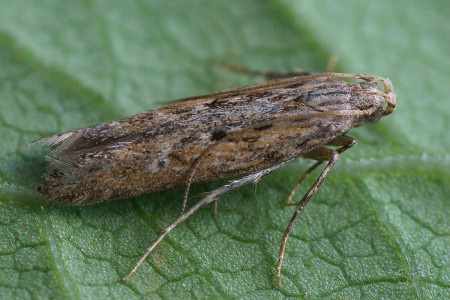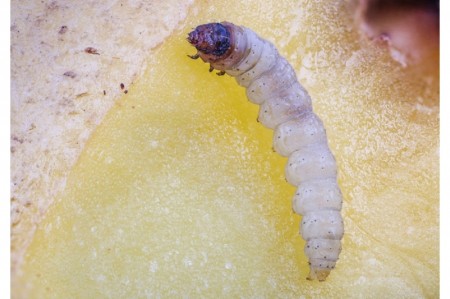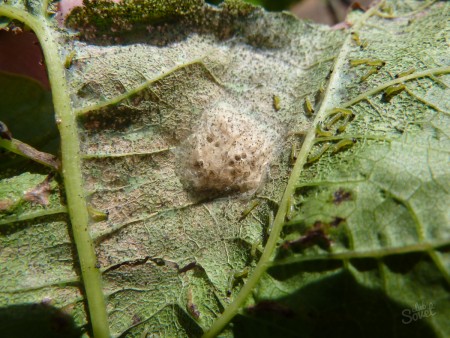Potato moths get into storage along with tubers - from the beds. There, the pest caterpillars feed on cultivated and wild plants of the nightshade family: potatoes, eggplants, peppers, tobacco, dope, etc.

Potato moth
Potato moth - a dangerous pest
True, to notice potato moth on plants, you need to be very careful: the pest is inconspicuous at all stages of development.A small, inconspicuous butterfly flies actively from evening to morning. The eggs that she lays near the veins, leaf petioles or on the stem are difficult to see because they are very small - only 0.4-0.8 mm.
Caterpillars form mines, and therefore they cannot always be detected, especially on potatoes, tomatoes, pepper Only when the pest population is high, its presence can be guessed by drooping tops with dried leaves. Moths can even damage tomato fruits.
The “presence” of caterpillars in tubers can be determined by the passages they leave and the accumulation of excrement. The caterpillar penetrates the tuber through eyes or cracks. At first it feeds under the skin, but gradually gets deeper. Damaged tubers do not store well. They cannot always be used for food even after radical pruning.
In the southern regions, where the winter temperature on the soil surface does not drop below minus 4 degrees, adult caterpillars and pupae can safely overwinter in open ground on plant debris under a small layer of soil.
The pest becomes active in early spring: at temperatures slightly above plus 8 degrees, butterflies begin to mate. The pest continues to reproduce and feed until late autumn, managing to produce 3-4 generations. The moth does especially a lot of damage to late potatoes: by the beginning of autumn it reaches its maximum number.
The damage to tubers in the garden depends on the phase of plant development and the depth of the tubers. There are few tubers infected with caterpillars, as long as the tops are green and the pest can feed on them. As soon as the tops dry out, the caterpillars actively colonize the tubers. The degree of damage depends on the depth of the tubers: the closer to the soil surface, the stronger it is.
But more than in the garden, potato moths harm tubers already in storage, especially in insufficiently cold ones. When the storage temperature drops to +3 +5 degrees, the pest loses activity. In the spring, along with the infected planting material, the pest moves into the beds and begins a new season.
Measures to combat potato moth
To prevent this from happening, seed tubers are treated with disinfectants. In private household plots, the drug Prestige is allowed to combat this harmful insect: 70-100 ml per liter of water. This amount of solution is enough to process 100 kg of tubers.
The disinfectant has a detrimental effect on pests not only at the time of processing, it protects potatoes from damage by potato moths, Colorado potato beetles, wireworms and during the initial growing season.
Agrotechnical measures will also help fight harmful insects.
- We plant healthy, undamaged seed tubers to a depth of at least 15 cm, since we know that potato moths do more damage closer to the soil surface. We plant potatoes early.
- As they grow, we hill up the potato bushes so that the emerging young tubers are well covered with soil.
- On the site and in its vicinity remove weeds the nightshade family (nightshade, henbane), on which potato moths can breed and feed.
- We dig up the potatoes without waiting for the tops to turn yellow and dry out.
- We try to remove the dug up potatoes from the site as quickly as possible: one day is enough for butterflies to lay eggs on the dug up tubers, from which caterpillars will hatch in storage.
- We do not leave substandard crops in the beds: small, cut tubers may contain a pest.In order not to destroy plant residues from the contaminated area, they can be filled with water, adding urea to the container, and after several days poured into compost.
- Late in the fall we dig up the area using a spade bayonet.
Having discovered potato moth on plants in spring or summer, the beds are treated with insecticides, repeating spraying after 10-15 days. The drugs used to combat the Colorado potato beetle are effective against moths.
Before digging, they are no longer treated with chemical insecticides with a long waiting period, but with biological ones: bitoxybacillin (40-100 g per 10 liters of water). All these measures will help you in the fight against potato moth.
When storing potatoes, it is important to sort them out as thoroughly as possible, discarding damaged tubers, and quickly reduce the temperature in the cellar or basement.
I. RYASNOVA, plant protection agronomist




 CUCUMBERS NEVER GET SICK, I'VE BEEN USING ONLY THIS FOR 40 YEARS! I SHARE A SECRET WITH YOU, CUCUMBERS ARE LIKE THE PICTURE!
CUCUMBERS NEVER GET SICK, I'VE BEEN USING ONLY THIS FOR 40 YEARS! I SHARE A SECRET WITH YOU, CUCUMBERS ARE LIKE THE PICTURE! You can dig a bucket of potatoes from each bush. Do you think these are fairy tales? Watch the video
You can dig a bucket of potatoes from each bush. Do you think these are fairy tales? Watch the video
 How our fellow gardeners work in Korea. There is a lot to learn and just fun to watch.
How our fellow gardeners work in Korea. There is a lot to learn and just fun to watch. Eye trainer.The author claims that with daily viewing, vision is restored. They don't charge money for views.
Eye trainer.The author claims that with daily viewing, vision is restored. They don't charge money for views. A 3-ingredient cake recipe in 30 minutes is better than Napoleon. Simple and very tasty.
A 3-ingredient cake recipe in 30 minutes is better than Napoleon. Simple and very tasty. Therapeutic exercises for cervical osteochondrosis. A complete set of exercises.
Therapeutic exercises for cervical osteochondrosis. A complete set of exercises. Which indoor plants match your zodiac sign?
Which indoor plants match your zodiac sign? What about them? Excursion to German dachas.
What about them? Excursion to German dachas.
At the moment, in Russia, it is the potato moth that most often spoils the potato harvest. Measures to combat this insect are not as simple as it might seem.